By: Nina Bagley
 Miss Lillian Love was born into a Quaker family in Marion, Indiana on October 24, 1880. Her family was from Decatur, Indiana. Her father, Granville Love, was born in Indiana. In 1860, he married Nancy J. Gillibrand. Her family came from England and settled in the vicinity of Indianapolis. The two were married on August 11, 1868, in Morgan County, Indiana. Granville was a farmer and ran a huckster wagon, which proved a good business. Mrs. Nancy Love had nine children from 1869 to 1892. She died on January 31, 1936, at eighty-six, in Decatur, Indiana. Lillian’s father, Granville Love, died May 7, 1925, in Guilford, Indiana. All the children would be trained in English and piano at Central Normal College in Danville, Indiana.
Miss Lillian Love was born into a Quaker family in Marion, Indiana on October 24, 1880. Her family was from Decatur, Indiana. Her father, Granville Love, was born in Indiana. In 1860, he married Nancy J. Gillibrand. Her family came from England and settled in the vicinity of Indianapolis. The two were married on August 11, 1868, in Morgan County, Indiana. Granville was a farmer and ran a huckster wagon, which proved a good business. Mrs. Nancy Love had nine children from 1869 to 1892. She died on January 31, 1936, at eighty-six, in Decatur, Indiana. Lillian’s father, Granville Love, died May 7, 1925, in Guilford, Indiana. All the children would be trained in English and piano at Central Normal College in Danville, Indiana.


Lillian’s parents, Granville and Nancy Love.
Lillian had two years of college, became a teacher, and taught in Indiana and Florida. Women still couldn’t find jobs other than teaching. Lillian and her youngest sister Flossie were involved in women’s rights and equal opportunity for women; they supported women’s rights to vote.
In 1904, Lillian moved to Tacoma, Washington, where she taught for several years. Finding her husband in 1907, she married Jay Levant Hill, who was twenty-five years older than her. Lillian’s husband, Jay, was an inventor who owned his own lumber business. Lillian said that her husband’s “brain was mechanically bent.”

Miss Lillian Love, taken in Washington State prior to her marriage to J. Levant Hill.
Their home would be Mount Shadow Ranch, a two-hundred-acre farm with a charming yellow California-style bungalow, two and a half miles from Elbe, Washington. Surrounding the farm were the bee’s favorite purple hills of fireweed.
Fireweed is a plant that enjoys cool and moist climates and thrives in Pacific Northwest forestlands. It is also considered one of the most prolific plants for honey production, with its nectar having a high sugar concentration. It has a “lightly spicy” or “buttery” flavor.
If you shut your eyes and listen, you can hear the train whistle in the distance as it stops at Park Junction Station in the middle of Mount Shadow Ranch.


1926 – Lillian Hill at Mt. Rainier
Apiary. Image featured in American Bee Journal
“We have some thirty acres under cultivation,” said Mrs. Hill; The rest of the farm is logged-off land which we use to pasture our herd of fifty cattle.”
—American Bee Journal, April 1926.
One day in 1913, an old man came peddling bees. “You have a wonderful place here for bees,” he said, convincing Mrs. Hill to invest in six swarms. Before the older man came along, she had never seen a swarm of bees before. Her six swarms increased and produced so much honey that in 1914 Lillian Hill invested in twenty more swarms, giving her forty hives. That year she harvested 6,500 pounds of pure honey. Lillian had an entrepreneurial spirit and determination to succeed in a male-dominated industry.

Lillian’s marriage to J. Hill.
I don’t know how she accomplished so much. Mrs. Lillian Hill kept a tidy home, raised beef cattle, Duroc-Jersey hogs, geese and ducks, and grew vegetables in the garden. But it would be the bees she loved the most!
Lillian was part owner of the Ranch and owner of the Mount Shadow Apiary. She had a gentle personality. She was independent and had a fire in her eyes that you could see demanded respect.
Being a novice beekeeper found her unprepared. In 1915, she encountered her first obstacle, European Foulbrood that would bring havoc to her beeyard. Words that no beekeeper wanted to hear or experience, the only cure, the dreadful burning of the hives. After that horrible experience with “American Foulbrood,” she only kept a dozen colonies of bees providing honey for her family and neighbors. (American Bee Journal, April 1926.)
“I never camp,” confessed Lillian Hill. “On either the trail of my successes or my failures. I go right on.” That’s her philosophy in a nut-shell.
Although childless, she cared for the children from reform schools, orphan asylums or neighboring farms; she taught the boys and girls everything about beekeeping so they could pay their way through school. She believed that the best and safest way to help any human being is to help him help himself. Particularly, those who needed guidance and education.
In the 1900s, the U.S. was a diverse nation, and its children lived in various circumstances. For years, she had been the leader of the Boys’ and Girls’ Bee Club of Elbe. One of her boys won nearly $80.00 with his exhibits of bees and honey at the Western Washington Fair.
Lillian increased her hives to twenty-six to help one of her boys and it didn’t stop there!
In 1924, to help one of her girls through school, she invested in thirty more hives and loaned them to the girl. The girl lived next door to an abandoned schoolhouse on an acre of ground, which got Mrs. Hill thinking, “I could rent the schoolhouse and land from the school board.”

1921 – Freddie May with his siblings before they were placed in the Washington Children’s Home.
One day in 1924, a young man showed up at the Ranch. His name was Freddie May, and he was born in 1912 in Denver, Colorado. When he was eight years old, he lived in Wenatchee, Washington. His father abandoned the family, and their mother could not care for six children. The children were placed in the Washington Children’s Home in Wenatchee, Washington, in 1921.

Mount Rainier Apiary. Freddie May and Mrs. Lillian Hill.
Freddie somehow got his hands on a newspaper. He came across the ad for a permanent position in beekeeping work. Freddie wanted to learn about the beekeeping business under the leadership of Mrs. Lillian Hill, so he rode on “a bicycle” from Wenatchee, Washington to Elbe, Washington, a hundred and ninety five miles! He was energetic and full of fire and wanted to learn beekeeping.
Lillian took a liking to Freddie and wanted to help him make money to pay his way through school, so she furnished Freddie with plenty of bees on a commission basis of fifty-fifty. In four months, the Colorado cyclist made five hundred dollars for himself.
Freddie would consider Mrs. Lillian Hill his mother and next of kin. Lillian and her husband would become Freddie’s foster parents giving him a home with security. He would attend Eatonville High School and work on the Ranch. He would continue beekeeping and eventually marry and have a family.
During the season of 1925, Mrs. Hill was able to establish the Colorado youth in the schoolhouse helping young boys and girls in need teaching them beekeeping.
In 1926, Lillian Hill had over one hundred and fifty hives of Italian bees, eighty-five at the schoolhouse and sixty-five at home. She produced at least 10,000 sections of comb honey. Mrs. Hill would advertise in the newspapers to get workers “Wanted – an experienced farmer for a permanent position.”
Most of the marketing she did herself in her Buick car. She supplied the best stores in Tacoma and Seattle. “I don’t have to hunt for a market,” declared this energetic woman. In one year, Mrs. Hill raised sixty queens. That was the part of her business that she enjoyed most of all. Mrs. Hill was the president of the Pierce County Beekeepers’ Association for two years.

Mount Rainier
Both triumphs and disasters have knocked often at Lillian Hill’s door on the Mount Shadow Ranch, but neither one ever fazed her. This woman had grit and plenty of it!
Around 1927, Freddie would accidentally run over Lillian’s foot crushing it while she was teaching him how to drive the tractor. An unfortunate outcome was that the doctors had to amputate her leg due to blood poisoning. Lillian had a prosthetic leg from the knee down, but that didn’t stop her. She took it in stride and persevered. In 1929, unfortunately, her husband died. He was the youngest of five and the last of his siblings. He was seventy-one years old. I will say some lives have more trial or tribulations than others, to be sure, but no life is without events that test and challenge us.
In the 1930 census, Lillian is listed as a widow forty-nine years old, with fifty men aged eighteen to sixty-six listed as boarders at the Mount Shadow Ranch and working for Lillian Hill. That’s a lot of men to manage. You would have to have grit and be firm! Among the fifty men working on the farm was Freddie May, the youngest, who was eighteen. His occupation was a Logger.
Not being able to care for the Ranch and losing her husband, not to mention the tractor accident, left her feeling like it would be time to sell the Ranch. Lillian Hill would place the Ranch up for sale.
Advertised in the Tacoma Daily Ledger Sunday, June 23, 1929. “Mountain Shadow Ranch. It is one of the best-stocked Dairy Farms in western Washington, with running water in every field and excellent soil. Forty acres cleared; 120 acres fenced for hogs and cattle; stocked and making money; good seven-room house with school buses to Elbe and Eatonville high school. The farm is a must-see to appreciate it. We will consider small trade—a price of $15,000. Write to Lillian L. Hill for an appointment.”

Family photo of Albert Cook, first wife Nora and their children.

Lillian’s family Bible.
A lot happened in 1930. The Ranch sold, and Lillian Hill married Albert Cook, a widower who worked in the lumber industry. His wife Nora passed away in March of 1929 at the age of fifty-one; they had six children together. Lillian didn’t mind an extended family. She was raising her niece Esther who she adopted at a young age and her foster son Freddie May. After all, Lillian loved children and teaching. Her first husband was in the lumber business so she probably knew Albert Cook.
Albert would marry Lillian in 1930, build apartment buildings and retire from the lumber industry. The two would live in Tacoma, Washington. Lillian’s beekeeping days came to an end, her new occupation would be owner and landlord of her apartment buildings.
Lillian had a very loving relationship for nineteen years with her husband Albert. In May of 1949, Albert passed away at the age of seventy-three. He was buried beside his first wife, Nora, in Tacoma, Pierce, Washington.
The income from the apartments and other investments would give Lillian a comfortable life for the next sixteen years. She lived to be eighty-eight and passed away August 19, 1969 in Tacoma, Pierce, Washington Lillian was a Sixth Avenue Baptist church member. She was buried next to her first husband, Jay Levant Hill.
Freddie May lived to be eighty-three years old. Freddie kept his surname May. He went by Fred (Cook) May, Sr. “Commander” as best by everyone who loved him.

Lillian in her sister Flossie’s backyard. Her dress is purple and black print. She and her sister Flossie always had a matching rhinestone necklace.
Lillian’s youngest sister Flossie, who she remained close with, lived in California. Flossie had a granddaughter Karla who enjoyed her aunt Lillian’s visits. She remembers sitting on her grandmother’s hunter green “davenport” with her aunt Lillian. Her grandma Flossie would sit in her desk chair across the room and the two sisters would talk for hours.
Lillian’s great-niece Karla also remembers how “intriguing” her aunt was. Lillian had blue eyes, was fair-haired and had rosy cheeks. She wore her hair in a braid reaching her waist until one day; she cut it off, curled it up, and put it in a small box for keeping. Karla remembers her Aunt Lillian as sweet but at the same time, tough and gutsy!
Marcus Aurelius was a stoic philosopher. His quote reminded me of Mrs. Lillian Love, her struggles as a woman in the 1900’s and how she put others before her, passing her knowledge about beekeeping on to so many young boys and girls in need. I would like to thank Lillian’s great-niece Karla Babcock for sharing her memories of her Aunt Lillian and grandmother Flossie.
“A life of sacrifice and putting the well being collective first, just like the bees.”
—Marcus Aurelius
Ohioqueenbee
Nina M. Bagley
Columbus, Ohio.
 Fresh Broccoli with Honey
Fresh Broccoli with HoneyBy: Fay Jarrett
Ingredients
□ 4 cups chopped broccoli
□ ¼ cup honey
□ 1 tbsp olive oil (tuscan herb was used this time)
□ ½ tsp pepper
□ ½ tsp salt
Directions
Step 1
Place chopped broccoli in a large bowl.
Step 2
Sprinkle honey, olive oil, salt and pepper over top. Stir.
Step 3
Cook broccoli in the microwave for four to five minutes, until desired tenderness.
Note
This a great addition to pork chops with hot honey drizzled on top.
Enjoy this easy, delicious dinner!
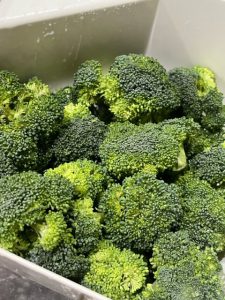
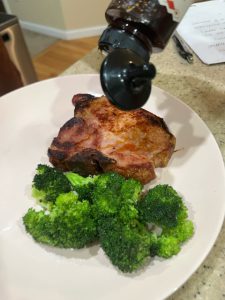
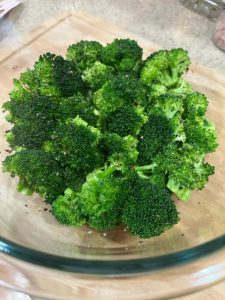
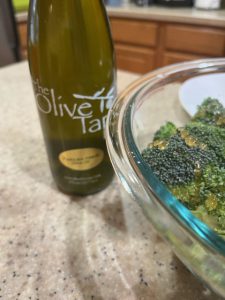
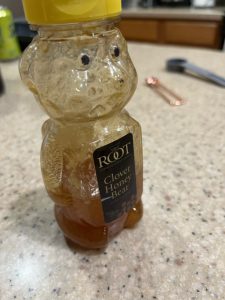
 Nestmate Recognition
Nestmate RecognitionBy: Clarence Collison
Pheromones are involved in intraspecific chemical communication; however, the glands associated with compounds used in nestmate recognition in honey bees remain elusive. This search is difficult since nestmate cues can arise from both within the colony, and from the environment (Kalmus and Ribbands, 1952). For example, Downs and Ratnieks (1999) found no evidence that honey bee guards used heritable cues; instead, guards appear to rely exclusively on environmental cues to distinguish nestmates from non-nestmates. However, nestmate cues can also be produced by the individual, and thus must be under genetic control (Breed, 1983; Page Jr. et al., 1991). A further factor is that the wax used to build comb in the colony is both produced and manipulated by the bees, which means it may be a medium into which recognition cues are transferred (Breed et al., 1998). Therefore, Breed et al. (1998) stated that no single factor is responsible for nestmate recognition in honey bees; rather, all three factors (genetically determined cuticular signatures, exposure to comb wax, and environmental cues e.g. floral cues) seem to work together (Martin et al., 2018).
Comb wax in honey bee colonies serves as a source and medium for transmission of recognition cues. Worker honey bees learn the identity of their primary nesting material, the wax comb, within an hour of emergence. In an olfactometer, bees discriminate between combs on the basis of odor; they prefer the odors of previously learned combs. Representatives of three of the most common compound classes in bee’s wax were surveyed for effects on nestmate discrimination behavior. Hexadecane, octadecane, tetracosanoic acid and methyl docosanoate make worker honey bees less acceptable to their untreated sisters. Other similar compounds did not have this effect. These findings support the hypothesis that nestmate recognition in honey bees is mediated by many different compounds, including some related to those found in comb wax (Breed and Stiller, 1992).
Breed et al. (1998) investigated how kin recognition cues develop and cue differentiation between honey bee colonies. Exposure to the wax comb in colonies is a critical component of the development of kin recognition cues. In this study, they determined how the cues develop under natural conditions (in swarms), whether the genetic source and age of the wax affect cue ontogeny, and whether exposure to wax, as in normal development, affects preferential feeding among bees within social groups. Cue development in swarms coincided with wax production, rather than with the presence of brood or the emergence of new workers; this finding supported previous observations concerning the importance of wax in cue ontogeny. Effective cue development required a match between the genetic source of the workers attempting to enter the hive, the wax to which they were exposed and the guards at the hive entrance. The wax must also have been exposed to the hive environment for some time. Cues gained from wax did not mask or override cues used in preferential feeding interactions; this finding supports the contention that two recognition systems, one for nestmate recognition and the other for intra-colonial recognition, are present.
Recognition of nestmates from aliens is based on olfactory cues, and many studies have demonstrated that such cues are contained within the lipid layer covering the insect cuticle. These lipids are usually a complex mixture of tens of compounds in which aliphatic hydrocarbons are generally the major components. Dani et al. (2005) tested whether artificial changes in the cuticular profile through supplementation of naturally occurring alkanes and alkenes in honey bees affect the behavior of nestmate guards. Compounds were applied to live foragers in microgram quantities and the bees returned to their hive entrance where the behavior of the guard bees was observed. In this fashion, they compared the effect of single alkenes with that of single alkanes; the effect of mixtures of alkenes versus that of mixtures of alkanes and the whole alkane fraction separated from the cuticular lipids versus the alkene fraction. With only one exception (the comparison between n-C19 and (Z)9-C19), in all the experiments bees treated with alkenes were attacked more intensively than bees treated with alkanes. This led them to conclude that modification of the natural chemical profile with the two different classes of compounds has a different effect on acceptance and suggests that this may correspond to a differential importance in the recognition signature.
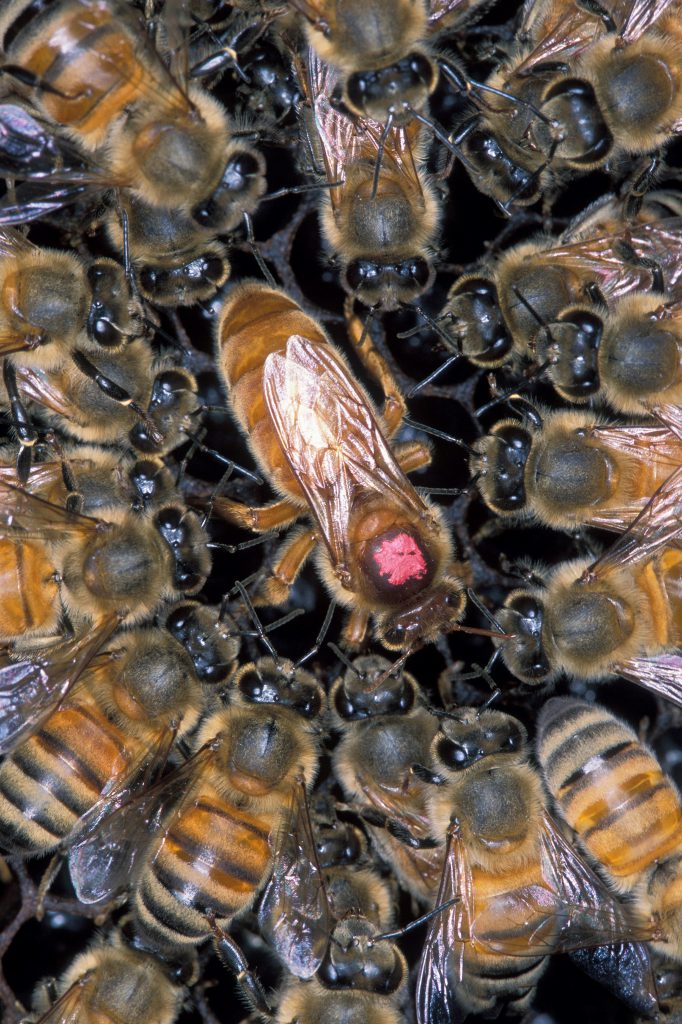 Cuticular hydrocarbons (CHCs) function as recognition compounds in honey bees. It is not clearly understood where CHCs are stored in the honey bee. Martin et al. (2018) investigated the hydrocarbons and esters found in five major worker honey bee exocrine glands, at three different developmental stages (newly emerged, nurse and forager) using a high temperature GC analysis. They found the hypopharyngeal gland contained no hydrocarbons nor esters, and the thoracic salivary and mandibular glands only contained trace amounts of n-alkanes. However, the cephalic salivary gland (CSG) contained the greatest number and highest quantity of hydrocarbons relative to the five other glands with many of the hydrocarbons also found in the Dufour’s gland, but at much lower levels. They also discovered a series of oleic acid wax esters that lay beyond the detection of standard GC columns. As a bee’s activities changed, as it aged, the types of compounds detected in the CSG also changed. For example, newly emerged bees have predominately C19-C23n-alkanes, alkenes and methyl-branched compounds, whereas the nurses’ CSG had predominately C31:1 and C33:1 alkene isomers, which are replaced by a series of oleic acid wax esters in foragers. These changes in the CSG were mirrored by corresponding changes in the adults’ CHCs profile. The CSG is a major storage gland of CHCs. As the CSG duct opens into the buccal cavity (mouth), the hydrocarbons can be worked into the comb wax and could help explain the role of comb wax in nestmate recognition experiments.
Cuticular hydrocarbons (CHCs) function as recognition compounds in honey bees. It is not clearly understood where CHCs are stored in the honey bee. Martin et al. (2018) investigated the hydrocarbons and esters found in five major worker honey bee exocrine glands, at three different developmental stages (newly emerged, nurse and forager) using a high temperature GC analysis. They found the hypopharyngeal gland contained no hydrocarbons nor esters, and the thoracic salivary and mandibular glands only contained trace amounts of n-alkanes. However, the cephalic salivary gland (CSG) contained the greatest number and highest quantity of hydrocarbons relative to the five other glands with many of the hydrocarbons also found in the Dufour’s gland, but at much lower levels. They also discovered a series of oleic acid wax esters that lay beyond the detection of standard GC columns. As a bee’s activities changed, as it aged, the types of compounds detected in the CSG also changed. For example, newly emerged bees have predominately C19-C23n-alkanes, alkenes and methyl-branched compounds, whereas the nurses’ CSG had predominately C31:1 and C33:1 alkene isomers, which are replaced by a series of oleic acid wax esters in foragers. These changes in the CSG were mirrored by corresponding changes in the adults’ CHCs profile. The CSG is a major storage gland of CHCs. As the CSG duct opens into the buccal cavity (mouth), the hydrocarbons can be worked into the comb wax and could help explain the role of comb wax in nestmate recognition experiments.
Worker honey bees are able to discriminate between combs on the basis of genetic similarity to a learned comb. The nestmate recognition cues that they acquire from the comb also have a genetically correlated component. Cues are acquired from comb in very short exposure periods (five minutes or less) and can be transferred among bees that are in physical contact. Gas chromatographic analysis demonstrates that bees with exposure to comb have different chemical surface profiles than bees without such exposure. These results support the hypothesis that comb-derived recognition cues are highly important in honey bee nestmate recognition. These cues are at least in part derived from the wax itself, rather than from floral scents that have been absorbed by the wax (Breed et al., 1995).
Experiments indicated that the most important recognition pheromones are the fatty acids, particularly palmitic acid, palmitoleic acid, oleic acid, linoleic acid, linolenic acid and tetracosanoic acid. These fatty acids are mixed with the wax hydrocarbons from wax glands, molded into comb and then transferred onto the workers as they contact the comb. The result is a colony level signature that varies little among workers in a colony. Newly emerged workers have few external fatty acids or hydrocarbons. Oleic acid is more abundant than the other fatty acids on newly emerged bees, but the amount of oleic acid on the cuticle does not vary significantly among colonies. Newly emerged workers are accepted even though they have no signature yet; the “password” for new bees to be admitted to their colony is apparently the lack of a signal. This conclusion is corroborated by the finding that guards tend to treat sodium hydroxide-washed older bees as if they are newly emerged (Breed, 1998).
The integration of recognition cues is described as follows. Fatty acids and hydrocarbons are components of the wax comb that is produced by the bees. The relative abundances of fatty acids and hydrocarbons in wax varies among colonies, giving them unique chemical signatures. Food odors may also be absorbed by the comb, adding to its uniqueness. Newly emerged bees produce their own hydrocarbon coating, which is modified as they move around the nest by the addition of hydrocarbons and fatty acids from the comb. Of the compounds tested in the laboratory, fatty acids are the most important recognition pheromones, but other, as yet untested compounds may also contribute to the recognition odor. Hydrocarbons have generally been assumed to be the primary recognition pheromones of honey bees. However, none of the major structural hydrocarbons of honey bees (i.e., n-alkanes) yields a positive result in a recognition bioassay, nor do these compounds differ significantly in relative concentration among families of bees (Breed, 1998).
The environmental and genetic components of recognition are difficult to separate even in controlled conditions. Getz and Smith (1983) showed that the honey bee discriminates between full and half-sisters raised in the same hive, on the same brood comb in neighboring cells, thus demonstrating a significant genetic component to the recognition process.
Nestmate recognition information can come from either contact chemoreception or olfaction. Mann and Breed (1997) investigated what role airborne olfactory cues play in nestmate recognition by honey bee colony guards, and how do these signals affect guard orientation and behavior? They demonstrated that airborne cues play a significant role in guard bee recognition of nestmates and non-nestmates. Exposure of a guard bee to the scent of a non-nestmate resulted in increased locomotory rate and changes in the directional orientation of guard bees. Exposure to scent of a non-nestmate did not, however, increase the likelihood that a second non-nestmate would be attacked when placed with the guard. Observations of guard behavior at colony entrances indicate that guards discriminate nestmates from non-nestmates with high efficiency.
Floral oils are an important component of the honey bee’s olfactory environment. Bowden et al. (1998) used laboratory and field tests to determine whether floral oils affect nestmate recognition in honey bees. In the laboratory, newly emerged worker bees, that have not been exposed to comb wax, responded more aggressively to bees that had been exposed to floral oils than unexposed control bees. In the field, guard bees did not respond differently to foragers that had been exposed to floral oils. Floral oils may play a supplementary role in nestmate recognition; however, if they have any effect, it is secondary to cues acquired from comb during development.
Downs et al. (2000) investigated the effect that floral oils (anethole, citronellal, limonene and linalool) have on the probability of nestmates and non-nestmates being accepted by guard bees at nest entrances. Floral oils did not affect the probability of workers, either nestmates or non-nestmates, being accepted by guards. However, the presence of floral oils did increase the time taken for a guard to reject an introduced bee. These data show that guards are sensitive to floral oils but use other recognition cues when assessing colony affiliation.
Honey bees have the ability to distinguish among groups of larvae that are destined to become queens and preferentially rear highly related nestmate larvae over less related larvae that are not nestmates (Page and Erickson, 1984).
Colonies of honey bees from two patrilines (cordovan and dark) were established and observations were made on the behavior shown by the worker bees in rearing queen larvae within their colonies. The relationship among the bees within these colonies was either r = ¾ (super-sisters) or r = ¼ (half sisters). The worker bees showed preferential care to the queen larvae that were of their own patriline. Workers of the cordovan patriline showed a stronger preference for larvae of their own patriline than did the dark workers. Cordovan workers also showed a higher rate of visitation, indicating behavioral differences between the patrilines. These results suggest that kin selection is operating on honey bee behavior used in rearing reproduction (Noonan, 1986).
A honey bee queen is usually attacked if she is placed among the workers of a colony other than her own. This rejection occurs even if environmental sources of odor, such as food, water and genetic origin of the workers, are kept constant in laboratory conditions. The genetic similarity of queens determines how similar their recognition characteristics are; inbred sister queens were accepted in 35% of exchanges, outbred sister queens in 12% and non-sister queens in 0%. Carbon dioxide narcosis (stuper, unconsciousness) results in worker honey bees accepting non-nestmate queens. A learning curve is presented, showing the time after narcosis required by workers to learn to recognize a new queen. In contrast, workers transfer results in only a small percentage of the workers being rejected. The reason for the difference between queens and workers may be because of worker and queen recognition cues having different sources (Breed, 1981).
Boch and Morse (1974, 1979) have shown that honey bee queens can be recognized individually by swarms of bees. They found that marking a queen with shellac-based paint to give her a distinctive odor resulted in workers later exhibiting a preference for any queen marked with that paint. However, their experiments do not show whether the odors used by workers to recognize queens are produced by the queens or are environmentally acquired. In a series of studies concerned with queen introduction into colonies, Szabo (1974, 1977) also found that workers could discriminate among queens, but did not approach the issue of the source of recognition odors directly. It was also found that factors such as the age and weight of an introduced queen could affect worker choice among introduced queens. Yadava and Smith (1971) found that the mandibular gland contents of the queen were important in the release of worker aggression towards an introduced queen (Breed, 1981).
References
Boch, R. and R.A. Morse 1974. Discrimination of familiar and foreign queens by honey bee swarms. Ann. Entomol. Soc. Am. 67: 709-711.
Boch, R. and R.A. Morse 1979. Individual recognition of queens by honey bee swarms. Ann. Entomol. Soc. Am. 72: 51-53.
Bowden, R.M., S. Williamson and M.D. Breed 1998. Floral oils: their effect on nestmate recognition in the honey bee, Apis mellifera. Insectes Soc. 45: 209-214.
Breed, M.D. 1981. Individual recognition and learning of queen odors by worker honey bees. Proc. Nat. Acad. Sci. USA. 78: 2635-2637.
Breed, M.D. 1983. Nestmate recognition in honey bees. Anim. Behav. 31: 86-91.
Breed, M.D. 1998. Recognition pheromones of the honey bee. Bioscience 48: 463-470.
Breed, M.D. and T.M. Stiller 1992. Honey bee, Apis mellifera, nestmate discrimination: hydrocarbon effects and the evolutionary implications of comb choice. Anim. Behav. 43: 875-883.
Breed, M.D., M.F. Garry, A.N. Pearce, B.E. Hibbard, L.B. Biostad and R.E. Page, Jr. 1995. The role of wax comb in honey bee nestmate recognition. Anim. Behav. 50: 489-496.
Breed, M.D., E.A. Leger, A.N. Pearce, and Y.J. Wang 1998. Comb wax effects on the ontogeny of honey bee nestmate recognition. Anim. Behav. 55:13-20.
Dani, F.R., G.R. Jones, S. Corsi, R. Beard, D. Pradella and S. Turillazzi 2005. Nestmate recognition cues in the honey bee: differential importance of cuticular alkanes and alkenes. Chem. Senses 30: 477-489.
Downs, S.G. and F.L.W. Ratnieks 1999. Recognition of conspecifics by honey bee guards (Apis mellifera) uses non-heritable cues applied to the adult stage. Anim. Behav. 58: 643-648.
Downs, S.G., F.L.W. Ratnieks, S.L. Jefferies, and H.E. Rigby 2000. The role of floral oils in the nestmate recognition system of honey bees (Apis mellifera L.). Apidologie 31: 357-365.
Getz, W.M. and K.B. Smith 1983. Genetic kin recognition: honey bees discriminate between full and half sisters. Nature 302: 147-148.
Kalmus, H. and C.R. Ribbands 1952. The origin of the odours by which honey bees distinguish their companions. Proc. R. Soc. Lond. B. 140: 50-59.
Mann, C.A. and M.D. Breed 1997. Olfaction in guard honey bee responses to non-nestmates. Ann. Entomol. Soc. Am. 90: 844-847.
Martin, S.J., M.E. Correia-Oliveira, S. Shemilt, and F.P. Drijfhout 2018. Is the salivary gland associated with the honey bee recognition compounds in worker honey bees (Apis mellifera)? J. Chem. Ecol. 44: 650-657.
Noonan, K.C. 1986. Recognition of queen larvae by worker honey bees (Apis mellifera). Ethology 73: 295-306.
Page, R.E. Jr. and E.H. Erickson Jr. 1984. Selective rearing of queens by worker honey bees: kin or nestmate recognition. Ann. Entomol. Soc. Am. 77: 578-580.
Page, R.E. Jr., R.A. Metcalf, R.I. Metcalf, E.H. Erickson Jr. and R.L. Lampman 1991. Extractable hydrocarbons and kin recognition in honey bee (Apis mellifera L.). J. Chem. Ecol. 17: 745-756.
Szabo, T.I. 1974. Behavioural studies of queen introduction in the honey bee 2. Effect of age and storage conditions of virgin queens on their attractiveness to workers. J. Apic. Res. 13: 127-135.
Szabo, T.I. 1977. Behavioural studies of queen introduction in the honey bee 6. Multiple queen introduction. J. Apic. Res. 16: 65-83.
Yadava, R.R.S. and M.V. Smith 1971. Aggressive behavior of Apis mellifera L. workers towards introduced queens II. Role of mandibular gland contents of the queen in releasing aggressive behavior. Cand. J. Zool. 49: 1179-1183.
Clarence Collison is an Emeritus Professor of Entomology and Department Head Emeritus of Entomology and Plant Pathology at Mississippi State University, Mississippi State, MS.
]]> By: Tina Sebestyen
By: Tina Sebestyen
The bottom line answer to the question, “Why do beekeepers give up?” is: because their bees die, usually over and over. They discover how hard it is to keep bees alive. Someone in my beginning beekeeping class always pipes up to ask why I say that it is hard to keep bees alive, when they live just fine all alone, on their own, out in the woods. That is not the only misconception new beeks start out with. Unfortunately, bees do not live just fine on their own without human help. In fact, they are never on their own, they are sickened and harmed by Varroa destructor constantly and thus 97.5% of colonies cannot live long without human help to control this honey bee predator.
It follows that new beekeepers who think that bees live fine on their own also don’t have any idea how much time they are going to need to take care of their bees. They don’t spend enough time getting comfortable handling the bees, so they’re unable to see and recognize when there is a problem. They aren’t doing good inspections. One of the leading indicators of bee survival is beekeeper experience. Every new beekeeper starts out with no experience, but getting in that hive every week and exploring, observing and manipulating (mite counts, anyone?) are where one can gain that valuable experience.
Once a beekeeper gets over their romanticized idea of beekeeping, decides to get serious and puts on their big kid pants, they often go to the internet to learn how to keep bees. Don’t get me wrong, not everything on the internet is bad or wrong… neither is it all good or right, and new beekeepers have no way of knowing which is which. Even if all of the information found on YouTube was correct, so much of beekeeping is local. It is dictated by whether or not water falls from the sky (I hear that is called rain, we don’t know it here in CO), temperature swings, timing and bounty of forage, the presence of small hive beetles and so many other things.
One of the things new beekeepers are looking for online is a recipe for beekeeping. Something like: feed until May 15th, add boxes on June 12th, split on X date. Unfortunately, beekeeping is not like baking cookies. You need to be able to observe what is happening, extrapolate what is about to happen and come up with a plan to help the bees do what they want to do. It also is not like owning a puppy or kitten, which you can run to the vet if something mysterious happens to their health.
Beekeeping is a lot more like owning livestock, maybe a herd of cattle. As such, their health needs to be safe-guarded in advance of trouble. They need water, adequate and varied forage, and protection from wind and predators. After trouble comes, it is harder to rectify than it would be with a pet.
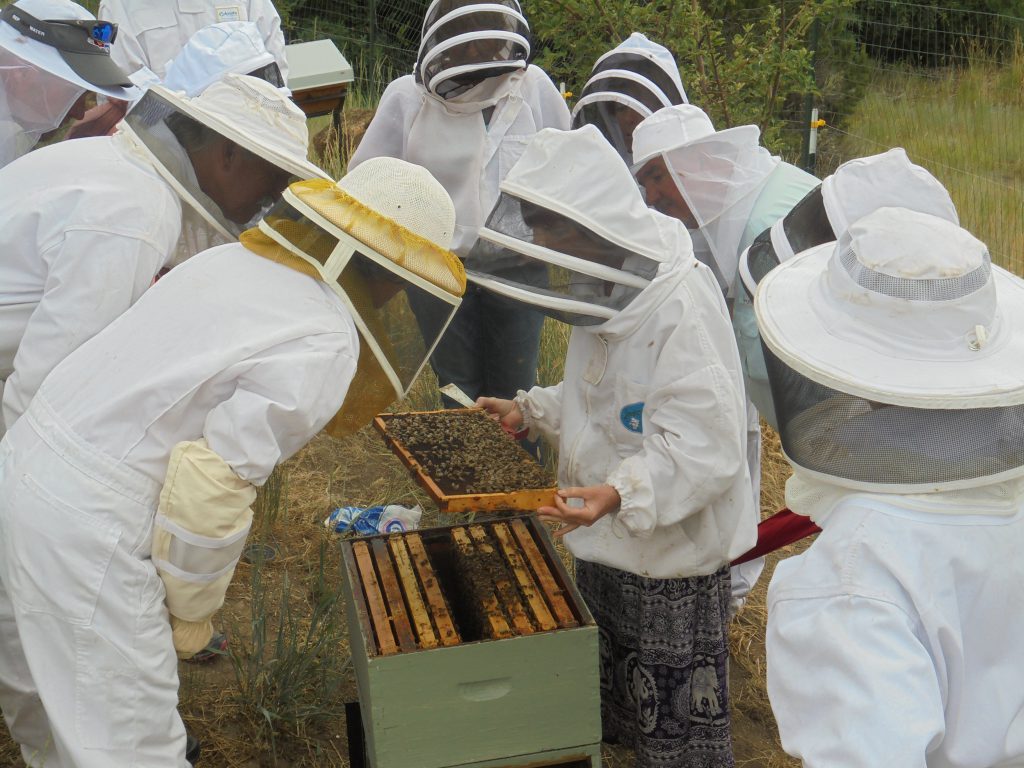
One great reason to join a bee club is that most have teaching apiaries. This time, we were having a potluck, and our host allowed us to go play with his bees. We often seek volunteers for apiary visits, which allows us to see surprising things, and gives a variety of situations to discuss, besides planned events at club hives.
Happily, there are solutions to these situations. One of the best, most fun, and most fruitful is to join a local bee club. Here you will find beekeepers who know what works in your area, starting with what sub-species of bee is right for you. These seasoned beeks love to share what they’ve learned the hard way, if you can just be humble enough to take them seriously, instead of thinking you’ll be able to make what wouldn’t work for them be successful for you.
One reason people don’t take the advice they are given is because they don’t understand the bee biology and behavior that is the reason behind the management or the timing of the decision. Our best beekeepers are those who read a lot about beekeeping. And, there is a lot out there. It has been said that more has been written about beekeeping than anything else besides religion. Again, what you find on the internet may have been written by a (notoriously over-confident) third year beekeeper. Books that have been published on paper by a real publisher, rather than a vanity, do-it-yourself publisher, have gone through at least some kind of vetting process. Bee journals do great reviews of such books, to help you know what will be readable and what is worthwhile information. Those journals themselves are a great source of current, vetted, information.
New (and old) beekeepers need to learn bee math, bee biology and management. These topics sound like what you wanted to avoid in high school, but they are a lot more fun in the real world, with real application in beekeeping. Once you get started, you’ll fall in love even more deeply with beekeeping. There is so much to discover and learn still!
And now to the brass tacks… beekeepers give up because bees die, and we need to learn about why they die and help them manage their challenges in advance. Bees have trouble with the five Problems. Pests, Pathogens, Poor forage, Pesticides and Politics. Every beekeeper has chosen one P, THE one that they think is THE problem, that if we just solved that one problem, everything would be great. Paying attention to one Problem without watching out for the others is another recipe for dead bees.
The most famous of the Pests is Varroa destructor, and undoubtedly, if we could solve that one, beekeeping would be a whole different proposition. But even without varroa, bees still need weeds which are in short supply in our world today, and varied sources of nectar and pollen throughout the collecting year. And, they still need a clean world to live in, one not poisoned by Pesticides. They need pro-active maintenance to be strong enough to overcome the Pathogens: viruses, bacteria and fungi. And they need us to have laws that are beneficial to their world and their keeping.
To sum it all up, if you want to continue to keep bees and have them live, so that you don’t get so frustrated with them dying all the time that you quit, here is what you need to do.
- Join a bee club and attend meetings in person. Get a mentor if you can.
- Read a lot about beekeeping, about bee biology and behavior, from books and magazines.
- Do what your mentor or local bee club advises, even if you don’t understand why right now.
- Learn to do an effective hive inspection. Plan to spend at least one hour per week on a pair of hives (one hive alone is a recipe for doom) for your first year, and at least one hour every other week thereafter.
Good luck, and happy beekeeping!
]]>Click Here if you listened. We’re trying to gauge interest so only one question is required; however, there is a spot for feedback!
Read along below!
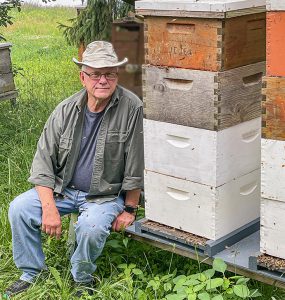 My Apiary Ecosystem
My Apiary Ecosystem
Honey bees are only a part of it.
By: James E. Tew
There’s always going to be something
In my hives or in my life, there is always going to be something – some issue or some problem. I literally just finished a phone call with one of my adult daughters. She had just eliminated a harmless Wolf Spider (Tigrosa annexa) because it frightened her young son (my nine-year old grandson). A few weeks ago, she had a problem with ants in her kitchen, but now they are gone. Now, she has Springtails (Collembola) in one of her bath showers. She complained to me that she feels that her home is under constant attack. I tried to tell her that there is always going to be something going awry. Always. Chill out. I don’t think she listened to me, but I listened to her.
Since I have spent my adult life studying honey bees, she assumed that I was also an information resource for Springtails. Readers, I don’t know anything about these small flea-sized arthropods, but unintentionally, my daughter set me to thinking and exploring. What do I know about Springtails? In all my beekeeping years, I have never asked or thought about the presence of Collembola in bee hives.
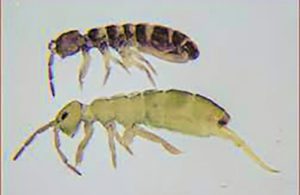
Figure 1. Springtails are about the size of a flea and seemingly cause no harm to bees or beekeeping.
Springtails are common in organic materials that are being degraded. On a whim, I keyed in a web search on Springtails (Collembola) in bee hives. I immediately got hits. All the citations that I found were from observant beekeepers. Having not found any information from academic or regulatory sources, I went to an AI open-source app and was given the following, undocumented information.
Collembola, commonly known as Springtails, are small arthropods that belong to the class Collembola. They are found in a wide range of habitats, including soil, leaf litter and decaying organic matter. While they are not typically associated with bee hives, it is possible for Springtails to be present in bee hives under certain conditions.
Springtails are detritivores, meaning they feed on decaying organic matter and microorganisms. In a bee hive, there may be small amounts of organic debris, such as pollen, beeswax and other residue, which could provide a food source for Springtails. However, the presence of Springtails in a bee hive is usually considered incidental and not a significant problem for honey bees.
I had no idea
I had no idea that these small animals could occasionally be found in hives, but my conversation with my daughter came at a time that I had been pondering this very concept. What is routinely in my bee hives and in my apiary other than honey bees? I have never found a comprehensive listing of the lifeforms that I could expect to find there.
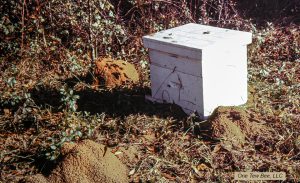
Figure 2. Fire ants and my honey bees. Do the ants help or hurt my bees? Ants, of many species, are common in my beeyard.
My apiary is essentially a distinct ecosystem. My apiary is where I keep my bees, but I have long since realized that many other species find that an apiary is home for them, too. These “unknowns” can apparently fall into three broad categories: harmful, beneficial or neutral.
The Big List
Early in our beekeeping journeys, we are exposed to what I have named the “Big List.” Some of the common entries on this list are raccoons, skunks, ants, wax moths, small hive beetles, birds, toads and mice. It is not my intent to discuss these common hive intruders here. Yet, in the hours and hours that I have either sat by my colonies or pawed through them, I routinely see other species and wonder what they’re up to as they bum around my hives. Usually, their presence remains a mystery.
Flies
Of course, there are numerous species of flies in and around my hives and colonies. We’ve all seen them. In fact, the classic book, Honey Bee Pests, Predators, & Diseases (Morse, Roger A. & Kim Flottum. Honey Bee pests, Predators, & Diseases. A.I.Root Company, Medina, Ohio. 44691. 718 pp. Chpt 8. P 143-162.) has a designated chapter on various fly species and their effects on bee colonies. Essentially, flies and their associated larvae are degraders and generally, do not have a harmful effect on healthy bees.
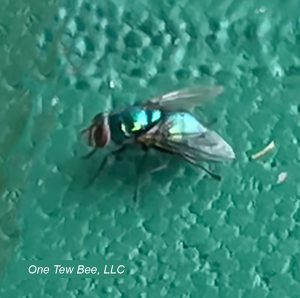
Figure 3. Common Green Bottle Fly (Blow Fly), probably Lucilia sericata, parked on the front of one of my active hives.
But, I can’t help but notice the occasional Green Bottle Fly nosing around my active hives. They are very flighty and will not allow a close camera shot before taking quick flight. Why are they there? I never see them get inside the hive.
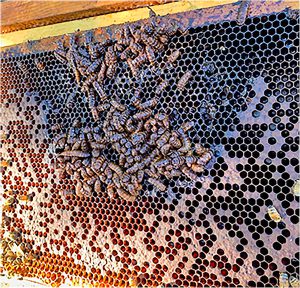
Figure 4. Black Soldier Fly larvae, H. illucens larvae, on honey bee frame. (Scott Razee photo)
But there are unique encounters between various Dipterous species and honey bees that are rare. Anthony (Auth, C. Anthony, Hauser, M. & Hopkins, B.K. A scientific note on a black soldier fly (Stratiomyidae: Hermetia illucens) infestation within a western honey bee (Apis mellifera) colony. Apidologie 52, 576–579 (2021). https://doi.org/10.1007/s13592-021-00844-y) published a scientific note on a Black Soldier Fly (Stratiomyidae: Hermetia illucens) infestation within a western honey bee (Apis mellifera) colony. In the article abstract, Anthony, et al. reported:
Black soldier Fly larvae (Hermetia illucens) were discovered in a weak honey bee colony in Hailey, Idaho. The larvae were localized to the brood area and caused the affected comb to putrefy. Further communication with the beekeeper revealed that the colony recently returned from California and that the larvae likely originated there as well. In California, H. illucens are common and exist sympatrically with honey bees, yet there have been very few reports of damage. We therefore believe H. illucens are unlikely to cause damage to healthy colonies or significantly impact the apiculture industry. This report is the first published observation of H. illucens in Idaho and shows conclusively for the first time that H. illucens associates with honey bee colonies in North America.
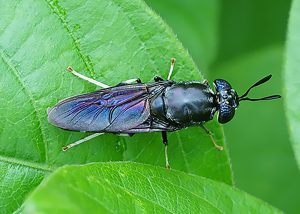
Figure 5. Adult Black Soldier Fly (Utah State University Extension)
There are distinct Diptera species that either are outright harmful to bees or other flies that are considered to be minor pests. Examples of damaging species are Phorid Flies (Zombie Flies) while a lesser pest is the bee louse (Braula caeca). These pests are documented elsewhere in the beekeeping literature. I will not cover them here.
Earwigs
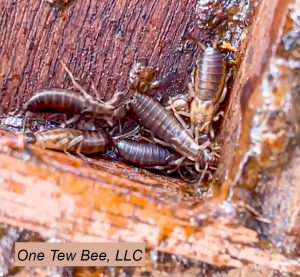
Figure 6. Adult European earwigs on the inner cover of my hive.
How bad can earwigs be? In Alabama, earwigs are commonly found in honey bee colonies in significant numbers. No doubt they are found in other states. I have noted that earwigs were not a common hive resident in Ohio, but that all changed a few years ago. I now have earwigs in my office, in my home and in my bee hives.
I don’t know that they do anything within the hive. I faintly remember one Russian paper, that reported that earwigs could be alternate hosts for the bacteria causing European Foulbrood. Other than that one point, I have never heard complaints about them.
Of course, they are a pain when extracting and must be caught in the filter when processing honey. Straining bees and bee parts from honey is bad enough, but earwigs in the honey filter are unsightly. I don’t know of anything that you can do about them. In fact, I’m not sure anything should be done about them.
Roaches
As an entomologist, I respect roaches. They are the consummate survivor. Obnoxious that they are to humans, one must respect their persistence. Many, many developmental years ago, roaches “learned” to fold their wings over their bodies so they could exploit more niches, than say, a broad-winged insect like a dragonfly (dragonflies will also occasionally prey on honey bees). By storing their folded wings over their bodies, cockroaches could, more easily, get under your refrigerator or inside your bee hives. They have been a challenge for me everywhere I have kept bees.
Like so many other insect visitors/invaders, roaches are drawn to both the sweet food supply as well as the protein supplies – and then there are all the decaying larvae and adult bees to munch on. The question is begged, “Why would roaches NOT be in our hives and stored equipment?”
In the beekeeping literature, it is often written that the damage roaches do is minimal, but I want to loudly say that the appearance of just a single roach in your honey house can dissuade even the staunchest customer who is considering buying your honey. And then there is the excreta to consider. In fact, one of my most serious concerns of both cockroaches and earwigs is the excrement that they leave behind.
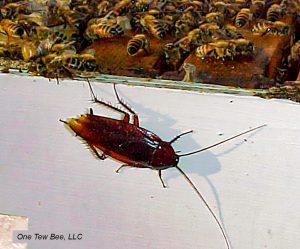
Figure 7. Unfortunately, a cockroach is not an uncommon hive visitor.
It is also commonly written that cockroaches are primarily found in weakened or otherwise ailing colonies. Yes, that is surely true, but I will loudly say that great numbers of roaches happily live on the inner cover of populous colonies. When the outer cover is removed, in a flash, they scamper down into the bees.
In my opinion, there is little to be done to control a roach infestation. Protecting the customer and protecting the purity of the honey product is about all that can be done. Yet, I cannot conclusively say that a modest roach infestation is absolutely harmful to the bees. Maybe future studies will continue to add information to this colony co-habitant.
Honey Bee Cousins
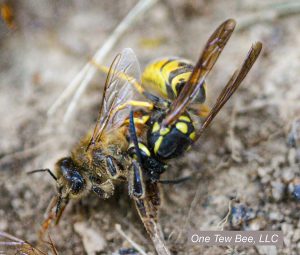
Figure 8. A yellowjacket lunching on one of my dead honey bees.
Yellowjackets
Though yellowjackets are on my “Big List” and are common pests in the beeyard, I have included them here. In my yards, these brightly colored insects could almost be a traditional resident of my apiary. Yellowjackets get included on my “mystery” list due to technicalities.
Yellowjackets (probably Vespula maculifrons) readily see their honey bee cousins as a potential food supply. On occasion, these wasps may have a nest in my apiary, but much more likely is that these hymenopterous insects are simply foraging within my apiary.
Experienced beekeepers have commonly seen yellowjackets mulling around the detritus at the hive entrance, but they will also enter a weakened colony and take honey, pollen, brood and adults depending on their own colony needs.
As such, yellowjackets get an entry on the common list of bee colony pests, but they do not seem to be the effective cause of the colony’s decline but are more commonly responding to a colony that has been weakened by other factors. Yellowjackets can be numerous when robbing behavior is rampant.
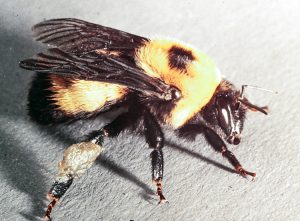
Figure 9. Bumblebees can frequently be seen attempting to enter a honey bee colony. This can be disastrous for the bumblebee with deadly results.
Bumblebees
I frequently see bumblebees trying to enter a bee colony. How suicidal is that? Only on a few occasions have I stumbled onto a bumble nest in unused honey bee equipment, but they are frequently in my apiary surely searching for food.
In fact, bumblebees may not necessarily be attracted to my honey bee colonies specifically, but they may be drawn to certain characteristics or resources associated with honey bee colonies. I can come up with a few reasons that may explain why bumblebees are sometimes found near my honey bee colonies:
- Floral resources: Honey bee colonies are known to forage on a wide variety of flowering plants to collect nectar and pollen. Bumblebees, like honey bees, are also generalist foragers and seek out similar floral resources.
- Odor cues: Honey bee colonies emit a combination of pheromones and odors that can be detected by other bees, including bumblebees. These chemical signals may serve as attractants, potentially drawing bumblebees to the entrance of the honey bee colony.
- Nesting opportunities: While honey bees typically nest in enclosed structures such as beehives or tree cavities, bumblebees often create nests in the ground or other protected locations. However, bumblebees may occasionally take advantage of abandoned honey bee hives or other suitable cavities near a honey bee colony, which could lead to their presence in the area.
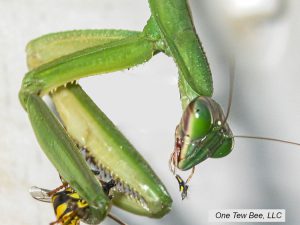
Figure 10. The apiary ecosystem can become complicated. This mantis is eating a yellowjacket that it caught while sitting atop one of my hives.
It’s important to note that interactions between bumblebees and honey bees can vary depending on the specific circumstances and the behavior of individual bees. While they may coexist peacefully in some cases, competition for limited resources, like nectar or nesting sites, can also occur.
My core point for this article
The apiary is an active place, but not only for honey bees. Many other common and not-so-common insects and animals hang around the beeyard foraging for food or shelter. You and I take a staunch view of these unwanted visitors. But truthfully, we do not know a lot about the complex interaction between all these other species and our honey bees.
For instance, Caron (Caron, Dewey. In Honey Bee Pest, Predators, and Diseases cited elsewhere in this article.), listed more than fifteen different beetle species that could be found in beehives – usually in the bottom board litter. Most beetle species had no ill effect on our bees, but I can’t help but wonder if some of those species could be beneficial to our honey bees. Currently, no one seems to know.
In this article, I have only tinkered with a few of the species that we can see with our unaided eyes. I made no effort to review the macroscopic visitors. Examples are: protozoans, fungi and nematodes. They’re all there, too. Readers, I sense that I’m describing a bee hive supermarket or maybe a big box store for insects.
Not wanting to run amok here, but it appears to me that the apiary is a significant food and shelter resource for a lot of other insects and animals. As beekeepers, we laud the effectiveness of the workers’ defensive stinger, but this protective device does not seem to be very effective against spiders, earwigs, birds or a fungus particle. I’m guessing that out of simple necessity, bees coexist with many of these interlopers. Hive visitors come in differing sizes and represent many diverse species.
Despite everything the bees and their keepers can do, the apiary will seemingly continue to be an attractive site for non-bee species. In this article, I’m trying to ask, “From a diversified ecological position, is this necessarily a bad thing?” Consider how many other species are being subsidized and nurtured by resources from our apiaries. Could it be said that our bee hives are “community centers” for a host of non-apis species? I think so. Blame my daughter. She started this.
Thank you for reading and thinking.
Dr. James E. Tew
Emeritus Faculty, Entomology
The Ohio State University
[email protected]
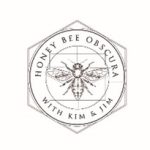 Co-Host, Honey Bee
Co-Host, Honey Bee
Obscura Podcast
www.honeybeeobscura.com
Click Here if you listened. We’re trying to gauge interest so only one question is required; however, there is a spot for feedback!
Read along below!
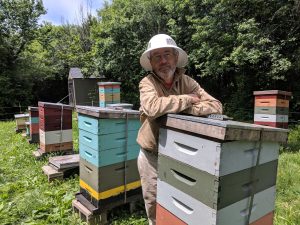
Pure Honey?
Probably Not So Much
By: Ross Conrad
Most widely known as components of Teflon coated cookware and firefighting foams, PFAS are extremely persistent in the environment. Researchers don’t really have a very good handle on how long it takes for them to actually break down, if they ever do, which is why they are sometimes referred to as forever chemicals.
PFAS Everywhere
Due to their unique properties, these chemicals are used in an extremely wide range of commercial, industrial and consumer products, including adhesives, building and construction materials, cleaning products, paints, varnishes and inks, cosmetics and personal care, dry cleaning, flea and tick products, electronics, explosives and ammunitions, the oil and gas industries, and the medical industry, among others (Gaines, 2021). A huge number of PFAS chemicals have been produced and distributed through the global supply chain, with over 9,000 PFAS related chemicals recorded dating back to before 1950 according to the Environmental Protection Agency Master list of PFAS substances (EPA).
High Level of Toxicity
Peer reviewed studies have connected exposure to certain PFAS chemicals to a host of human health problems including reproductive effects such as decreased fertility or increased high blood pressure in pregnant women, developmental effects or delays in children, increased risk of some cancers, suppression of the body’s immune system and interference with the body’s natural hormones, along with increased cholesterol levels and/or risk of obesity (EPA, 2023). Some of these chemicals are so toxic that in 2022, EPA released a lifetime drinking water health advisory for four PFAS substances – not in the amounts of parts per million, or parts per billion, but in the fractions of parts per trillion range (U.S. Gov., 2022).
Health effects associated with exposure to PFAS are difficult to nail down for many reasons. Although there are thousands of PFAS with potentially varying effects and toxicity levels, most studies have focused on a limited number of better known PFAS compounds. Meanwhile, people can be exposed to PFAS in different ways and at different stages of their life, and the types and uses of PFAS change over time. All of this makes it challenging to track and assess how exposure to these chemicals occurs and how they will affect human health.
Honey Bee Exposure
In the June issue of Bee Culture, I note that PFAS used in plastic manufacturing (most notably in high density and low density polyethylene – HDPE & LDPE) has the potential to leach out of plastic hive components and impact bees and honey. Well, it turns out there is yet another avenue for PFAS to potentially make its way into our hives: pesticides (Lasee et al., 2022).
PFAS chemicals are being found in a wide variety of pesticides. Sometimes, the PFAS is the active ingredient or added as an adjuvant, or so called “inert” ingredient included in the pesticide formulation to enhance the effectiveness of the active ingredient. Other times, the levels of PFAS found in a particular pesticide is so small it is likely a result of the chemical leaching out of plastic packaging and into the pesticide or its components prior or during manufacture. Since pesticides are applied to our food crops, researchers are documenting PFAS chemical build up (bioaccumulation) in fish, animals and people.
Officials in the state of Maine found that more than 1,400 pesticides contain active ingredients that meet the state’s definition of PFAS (EWG, 2023). Researchers have also documented the migration of toxic pesticides from the surrounding environment into honey bee colonies.
The common presence of PFAS in pesticides, potentially including those many beekeepers place in their hives, is concerning not just from a human perspective but also from the bee’s. A small but growing body of research reveals the potential for adverse impacts of PFAS exposure in honey bee colonies. One researcher found that a honey bee’s oral exposure to PFOS resulted in a 72-hour oral median lethal dose (LD50) of 0.40 mg per bee (Wilkins, 2001). Meanwhile, a correlation between the bioaccumulation of fluorinated pesticides in honey bees, along with other types of pesticides, and mass mortality events of honey bee colonies has been documented (Martinello et al., 2019). Another study found that not only do PFAS have the potential to adversely impact honey bees, they can migrate into honey, the primary source of carbohydrate and energy for honey bees and one of the primary hive products produced by beekeepers (Sonter et al., 2021). Given the well-established fact that pesticides are commonly found in honey samples, it should come as no surprise if further testing uncovers widespread PFAS contamination in honey sold for human consumption.
States Taking the Lead
PFAS contamination presents a mostly unexamined problem for farmers all across the country. Prior to the recent revelation of PFAS contamination of pesticides, farmland has historically been contaminated with PFAS through the spreading of waste water treatment plant sewage sludge as an agricultural fertilizer. Another acknowledged source of contamination is the leaching of PFAS chemicals off military bases onto nearby farms and water supplies.
As part of the effort to get a handle on this situation, Maine has become the first state to enact a comprehensive ban on pesticides that include intentionally added PFAS, as well as pesticides contaminated with PFAS. The ban is currently set to take effect in 2030.
A second state to move to ban PFAS is Minnesota. Scientist’s understanding and ability to detect PFAS in the environment has evolved greatly since the Minnesota Pollution Control Agency (MPCA) and the Minnesota Department of Health (MDH) began investigating them back in 2002. Laboratories at that time had only identified two PFAS and extremely low concentrations were undetectable given the existing technology at that time. Today, we are able to measure extremely small amounts (parts per trillion) of several PFAS. As noted before, studies have linked long-term exposure to PFAS in this range to negative outcomes especially for the most vulnerable members of our population: children, the elderly, pregnant women and those with compromised immune systems.
The writing is on the wall when it comes to PFAS compounds. One of the world’s primary PFAS manufacturing companies, 3M, has agreed to pay more than $10 billion to settle lawsuits claiming it knowingly used “forever chemicals” in its products despite being aware of risks to human health. Additionally, 3M says it’s phasing out two common compounds – PFOS and PFOA – and has announced that they will discontinue all types of the chemicals by 2026. Unfortunately, history has shown that companies usually only phase out a toxic compound when they have a replacement ready for market. Typically, the replacement is just as harmful as the compound it replaces, but it takes decades to accumulate the data showing harm and require the replacement chemical to also be withdrawn. Of course by then, yet another toxic replacement is found.
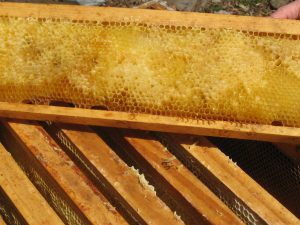
Regularly rotating old comb out of hives is one way beekeepers can reduce toxic chemical loads on bee colonies. The color of the comb is not a reliable indication of the age of the comb, since combs that are only used by the bees or food storage take much longer than brood combs to darken.
Varroa Treatments
The commonly used beekeeping pesticide Amitraz (sold as Apivar) was not found to contain any fluorinated chemicals that would meet the state of Maine’s definition of PFAS. However, Fluvalinate, the active ingredient in Apistan does meet the state’s definition.
I spoke with pesticide toxicologist, Pam Bryer of the Maine Board of Pesticide Control who pointed out that the PFAS problem could easily have been avoided if all chemicals were treated like pesticides which are regularly tested for their persistence in the environment. According to Bryer, “for most of the PFAS out there, there is almost no data.” Bryer assured me that unlike PFOS and PFOA which are long chain fluorinated compounds, fluvalinate is not nearly as toxic since it contains a short chain fluorinated methyl group. She did express concern, however what can happen should the fluorinated methyl group in fluvalinate combine with other chemicals potentially forming more toxic compounds or potent green-house gases.
Better Safe Than Sorry
In my mind, the safest treatments available to beekeepers today are those that utilize organic acids. By definition, the acids are not toxic, though they are corrosive. All of the organic acids (formic, oxalic and hop beta) that are approved for use to control varroa mites become neutralized over time and leave behind no harmful residue from the acid. Unfortunately, we now know that PFAS have the potential to make their way into such otherwise relatively safe products and contaminate our colonies despite our best efforts.
Beekeepers don’t have to wait for regulatory action and should consider increasing their reliance on natural and organic approaches, or when possible, treatment-free management techniques to control mites. As beekeepers, we can reduce or even eliminate toxic chemical use in our hives starting today by incorporating organic practices into our hive management. One way is to regularly rotate old combs out of hives and allow colonies to build new comb so the level of residue buildup in wax remains relatively low. Another approach discussed in my book, Natural Beekeeping, includes the use of screened bottom boards, culling capped drone brood, forcing a brood break in the hive, and propagating strains of bees that show some resistance to mites and diseases. A trial that ran between 2016-2019 found that combining all five of these physical and biological treatment-free management approaches can control mite-related hive mortality and ensure survivability on par with commercially available pesticide treatments (Conrad, 2021).
Recently, researchers Robyn Underwood, Margarita López-Uribe and their team from Penn State and Virginia Tech published a study on organic beekeeping in which they “… found that the organic management system-which uses organic-approved chemicals for mite control-supports healthy and productive colonies, and can be incorporated as a sustainable approach for stationary honey-producing beekeeping operations.” (Underwood et al., 2023).
As Rachel Carson noted over 60 years ago: “The most alarming of all man’s assaults upon the environment is the contamination of air, earth, rivers and sea with dangerous and even lethal, materials. This pollution is for the most part irrecoverable; the chain of evil it initiates not only in the world that must support life, but in living tissues is, for the most part, irreversible.” (Carson, 1962). Given that we now have effective low toxic and non-toxic alternatives to dangerous chemicals, why continue to play Russian roulette with pesticides?
Ross Conrad is author of Natural Beekeeping, Revised and Expanded 2nd edition, and co-author of The Land of Milk and Honey: A history of beekeeping in Vermont.
References:
Carson, Rachel (1962) Silent Spring, The Riverside Press Cambridge, Houghton Mifflin Company, Boston pg 6
Conrad, Ross (2021) Comparison of a commercial Varroa mite honey bee treatment with treatment-free Varroa management techniques, Bee Culture September: pp 41-45
Environmental Protection Agency, Comptox Chemicals Dashboard: Master List of PFAS Substances (Version 2). Accessed June 26, 2023. https://comptox.epa.gov/dashboard/chemical_lists/pfasmaster
Environmental Protection Agency (2023) Our current understanding of the human health and environmental risks of PFAS, accessed June 21, 2023 https://www.epa.gov/pfas/our-current-understanding-human-health-and-environmental-risks-pfas
Environmental Working Group (EWG), Maine data unveils troubling trend: 55 PFAS-related chemicals in over 1400 pesticides, accessed June 13, 2023 – https://www.ewg.org/news-insights/news-release/2023/06/maine-data-unveils-troubling-trend-55-pfas-related-chemicals
Gaines, Linda G.T. (2001) Historical and current usage of per- and polyfluoralkyl substances (PFAS): A literature review, American Journal of Industrial Medicine, 66:353-378
Lasee, S. et. al. (2022) Targeted analysis and total oxidizable precursor assay of several insecticides for PFAS, Journal of Hazardous Materials Letters, 3:100067
Martinello, M. et. al. (2019) A survey from 2015 to 2019 to investigate the occurance of pesticide residues in dead honey bees and other matrices related to honey bee mortality incidents in Italy, Diversity, 12(1):15
McCarthy, C., Kappleman, W. & DiGuiseppi, W. (2017) Ecological Considerations of Per- and Polyfluoroalkyl Substances (PFAS). Curr Pollution Rep 3, 289–301
Steven Lasee, Kaylin McDermett, Naveen Kumar, Jennifer Guelfo, Paxton Payton, Zhao Yang, Todd A. Anderson, (2022) Targeted analysis and Total Oxidizable Precursor assay of several insecticides for PFAS, Journal of Hazardous Materials Letters, Vol. 3.
Sonter, C., Rader R., Stevenson, G., Stavert, J., Wilson, S.C. (2021) Biological and behavioural responses of European honey bee (Apis mellifera) colonies to perfluorooctane sulfonate (PFOS) exposure, Integrated Environmental Assessment and Management, 17(2)
United States Government (2022) Lifetime Drinking Water Health Advisories for Four Perfluoroalkyl Substances [FRL 9855-01-OW], Federal Register 87:118 pp 36848-36849
Underwood, R.M., Lawrence, B.L., Turley, N.E., Cambron-Kopco, L.D., Kietzman, P.M., Traver, B.E., López-Uribe, M.M. (2023) A longitudinal experiment demonstrates that honey bee colonies managed organically are as healthy and productive as those managed conventionally, Scientific Reports, 13:6072 https://doi.org/10.1038/s41598-023-32824-w
Wilkins, P. (2001) “Perfluorooctanesulfonate, potassium salt (PFOS): An acute contact toxicity study with the honey bee. Study number HT5601.”
Click Here if you listened. We’re trying to gauge interest so only one question is required; however, there is a spot for feedback!
Read along below!
Found in Translation
Sweet and Sour Honey
By: Jay Evans, USDA Beltsville Bee Lab
There are many ways that honey bees improve our diets but honey consumption was an early reason to wrangle this species. The taste for honey persists today around the world, sustaining sideliners, families and large corporations in many parts of the world. It is also widely known to soothe and improve relations with neighbors, in-laws and bosses. With any high-value product, there is a risk of inadvertent or purposeful false advertising.
One honey quality trait that is easy to control is water content. Small-scale beekeepers routinely put their honey crops and relationships at risk by bottling honey that hasn’t been fully processed by bees to a net water percentage under 19%. Watery honey both feels weird and is prone to unintended fermentation. Choosing properly capped frames goes a long way to eliminating this problem. If you live in a humid place like Maryland, there is also some risk that open honey will dehumidify some of the local air, pushing water content back above dangerous levels. Truly dry honey can be achieved by technique and awareness, but if you are curious and want to directly assess the water content of your crop, Hanna Bäckmo gives a nice review of the styles and costs of refractometers used by beekeepers in this magazine (https://www.beeculture.com/refractometer/). Certainly, steady honey producers would benefit from investing in, and calibrating, these things.
A bit out of reach for most of us, but essential for the industry, are lab-based assays aimed at confirming honey purity. The methods used for this continue to improve, putting clumsy or sneaky honey producers on notice. Notably, honey yields can be stretched by a variety of refined or expelled sugars. This might be inadvertent, when syrup fed by beekeepers in the Fall for Winter survival lingers, capped until Spring. There is no easy answer to this, certainly not from me, but step one is to get bees through Winter safely, and then assess any remaining capped stores to see if these stores are bona fide honey or syrup that bees dried down but didn’t gobble up as it came in. Ask a beekeeper near you for help.

Photo by Meggyn Pomerleau on Unsplash
More insidiously, producers or packers might outright add less expensive fillers to their honey, increasing yields but losing some of the magic of honey. The technology used to detect such adulteration is improving, and several techniques are now used by regulators, producers and packers to make sure honey is pure. The International Honey Commission described forensic methods for honey purity nearly 30 years ago and updated these methods in 2009 (https://www.bee-hexagon.net/english/network/publications-by-the-ihc/). The U.S. Food and Drug Administration, keeping honest folks honest across the industry, regularly tests new methods against imported and domestic honey to identify so-called ‘economically motivated adulteration’. Using a well-established technique, Stable Carbon Isotope Ratio Analysis (SCIRA), the FDA recently screened bulk and bottled honey samples from eight countries whose honey is imported into the U.S. (https://www.fda.gov/food/economically-motivated-adulteration-food-fraud/fy2122-sample-collection-and-analysis-imported-honey-economically-motivated-adulteration). This test distinguishes ‘C4’ plant sources (largely grasses and grains) from ‘C3’ sources (all the plants with prettier, bee-visited, nectar-rich flowers). The test simply asks if the unexpected C4-sugars, often from corn syrup or sugar cane, are over-represented in honey. There is some tolerance of these C4 sugars due to bee management or assay imprecision but that level is quite low, maybe 7% by volume. Each country in the FDA screen had at least one suspicious honey batch, but the overall frequency of such batches was 10%, a level roughly similar to a much larger recent study in Europe and indicative that honey, by and large, is as advertised.
There are several newer techniques in play now for the high-stakes race between regulators and those who might diminish the reputation of honey. Dilpreet Singh Brar and colleagues in A comprehensive review on unethical honey: Validation by emerging techniques (Food Control 2023, 145, 109482, https://doi.org/10.1016/j.foodcont.2022.109482) describe nearly 50 ways to test your clover. Within the alphabet soup of available methods, they reveal six chromatographic platforms (basically methods to separate parts of a whole by size, electric charge or affinity to some sort of ‘bait’) with increasing sophistication. These machines should put fear in anyone whose honey is not perfectly sound.
As a geneticist, I am fascinated with so-called environmental DNA (eDNA) screens, whereby a complex soup is scrutinized for the genomes of the diverse organisms floating in it. Many will remember the application of eDNA screens worldwide to identify levels and variants of the SARS-Cov-2 virus in city and town wastewater systems (poor interns!; https://www.nih.gov/news-events/nih-research-matters/tracking-sars-cov-2-variants-wastewater). This same methodology is now widely used to confirm the botanical sources of honey, the genotypes of the bees collecting that honey and the myriad of other organisms from the hive environment. Practically, this method also precisely identifies any honey contaminant with a biological source, from corn syrup to diverse flower sources mixed in accidentally in coveted monofloral honeys. It is also a sensitive assay for honey bee disease agents.
For the past 20 years, genetic analyses of honey from hives have been used to confirm the presence of the bacterium responsible for American Foulbrood, Paenibacillus larvae. Federico Lauro and colleagues in Rapid detection of Paenibacillus larvae from honey and hive samples with a novel nested PCR protocol (International Journal of Food Microbiology 2003, 81, 195-201, https://doi.org/10.1016/S0168-1605(02)00257-X) showed the value of this technique for keeping track of non-symptomatic P. larvae populations. More broadly, Leigh Boardman and others have confirmed that this technique can provide a snapshot of the whole range of microbes found in colonies (Boardman, L., P. Marcelino, J. A., Valentin, R. E., Boncristiani, H., Standley, J. M., & Ellis, J. D. Novel eDNA approaches to monitor Western honey bee (Apis mellifera L.) microbial and arthropod communities. Environmental DNA. 2023; https://doi.org/10.1002/edn3.419). Here, colony-collected honey is analogous to the worker-bee samples now used in many disease surveys. Honey collections have the added value of pointing out long-ago arrivals, providing a sort of fossil record for the plants and other organisms a colony might have come into contact with during the past year. The genetic methods behind these screens are astoundingly sensitive (remember, viruses floating alone in tons of sewer sludge) and honey or hive-based screens have promise for anything from virus outbreaks to the detection of newly invasive mites and other pests. It is incredibly hard to pass through an environment without shedding a little DNA, and a little goes a long way for these sensitive methods.
Economically motivated adulteration is detectable with some effort and that’s a good thing for all of us. Honey screening, especially with the twist of identifying genetic signals from hive organisms, is also becoming a nice tool for scientists keen on monitoring disease, plant sources and the genes of the bees that did all the work.
]]>